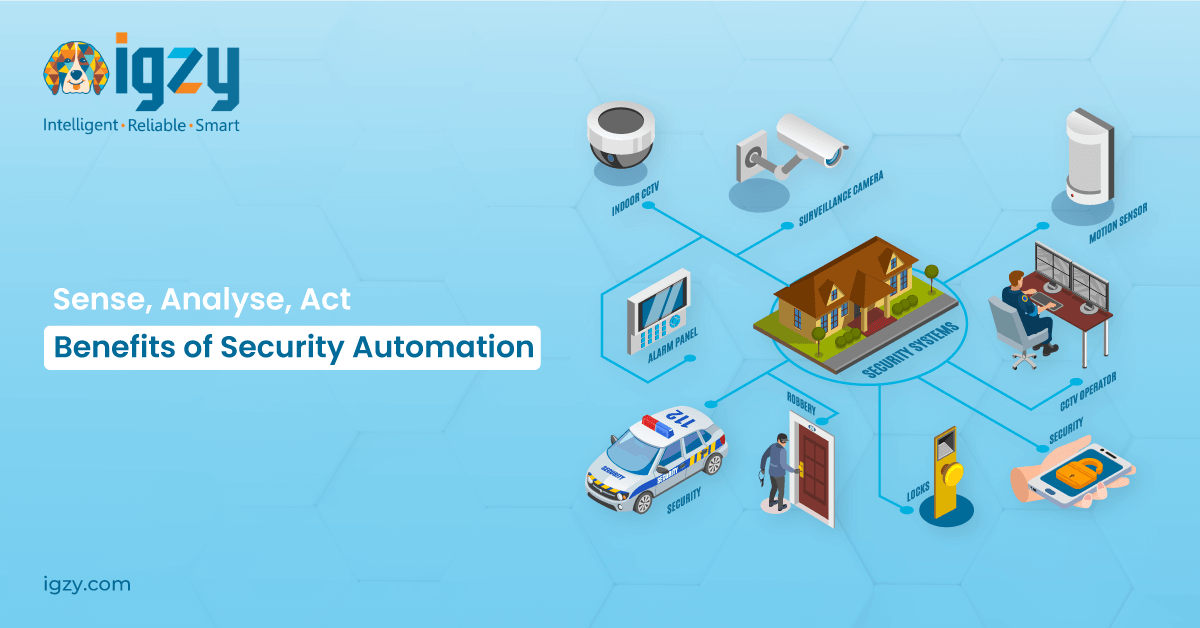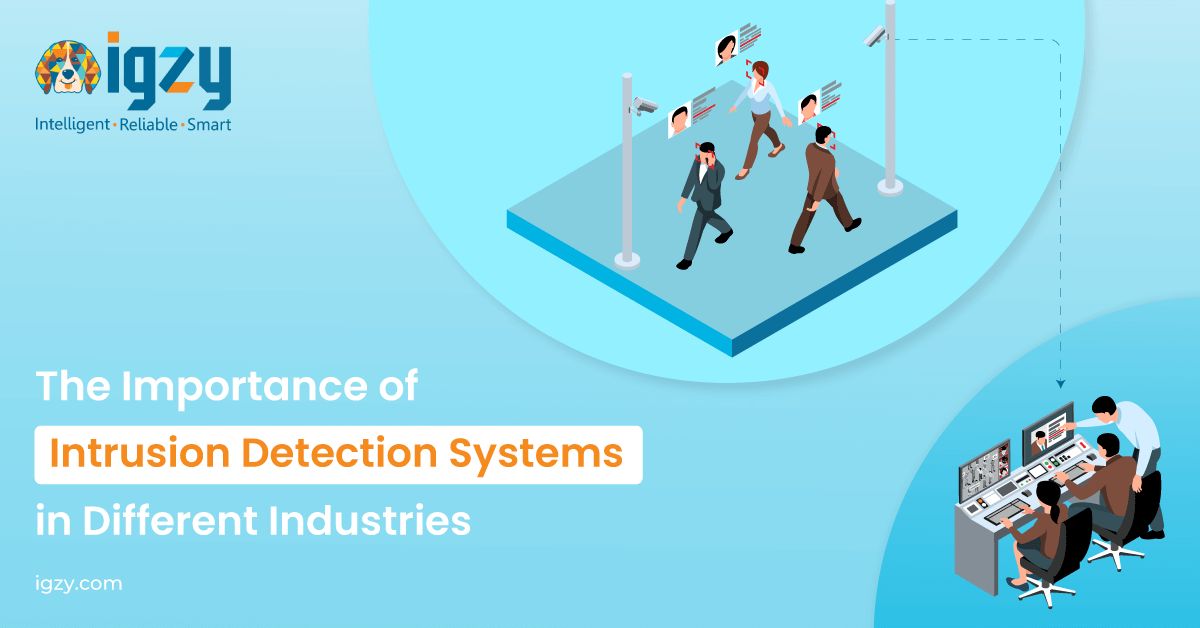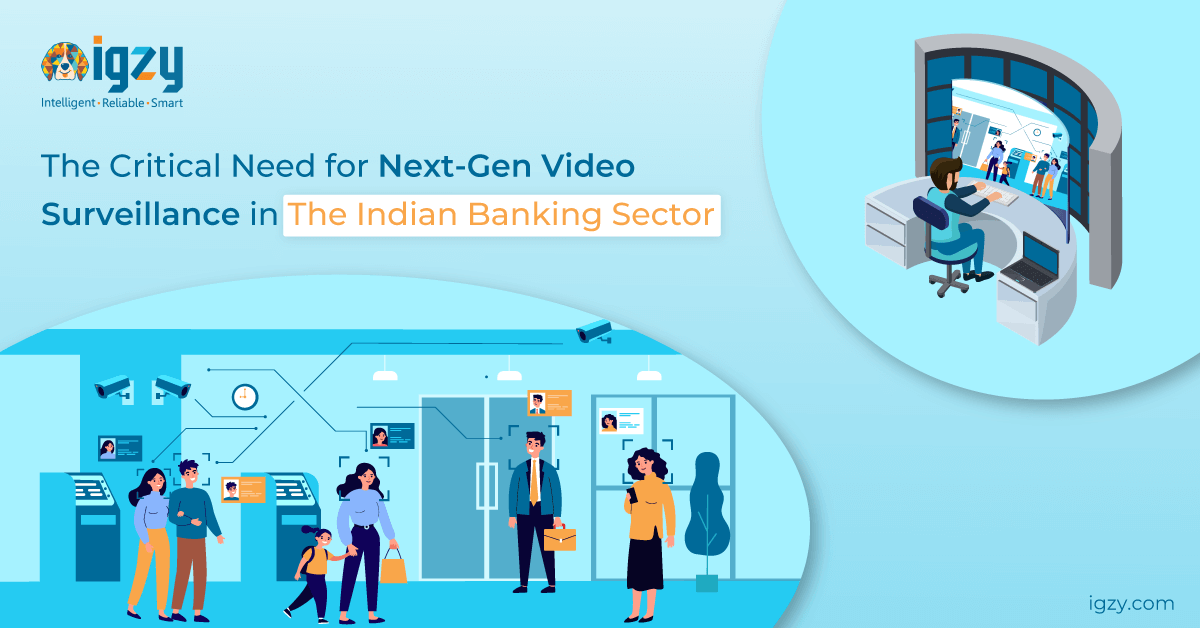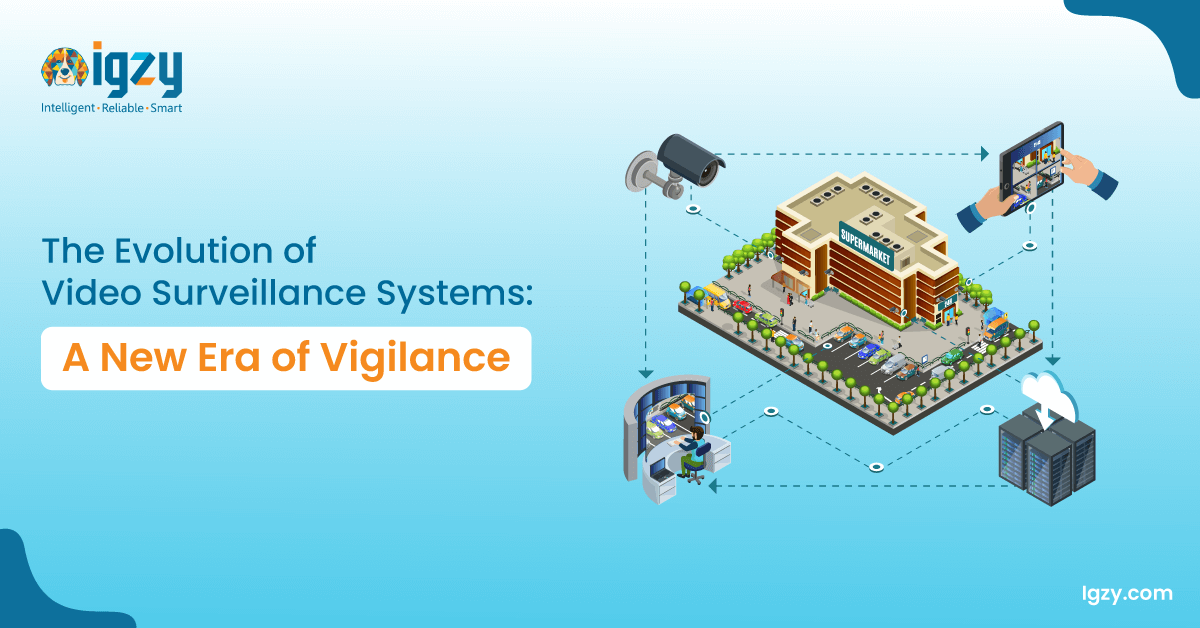What Is Cloud Video Surveillance? A Comprehensive Guide
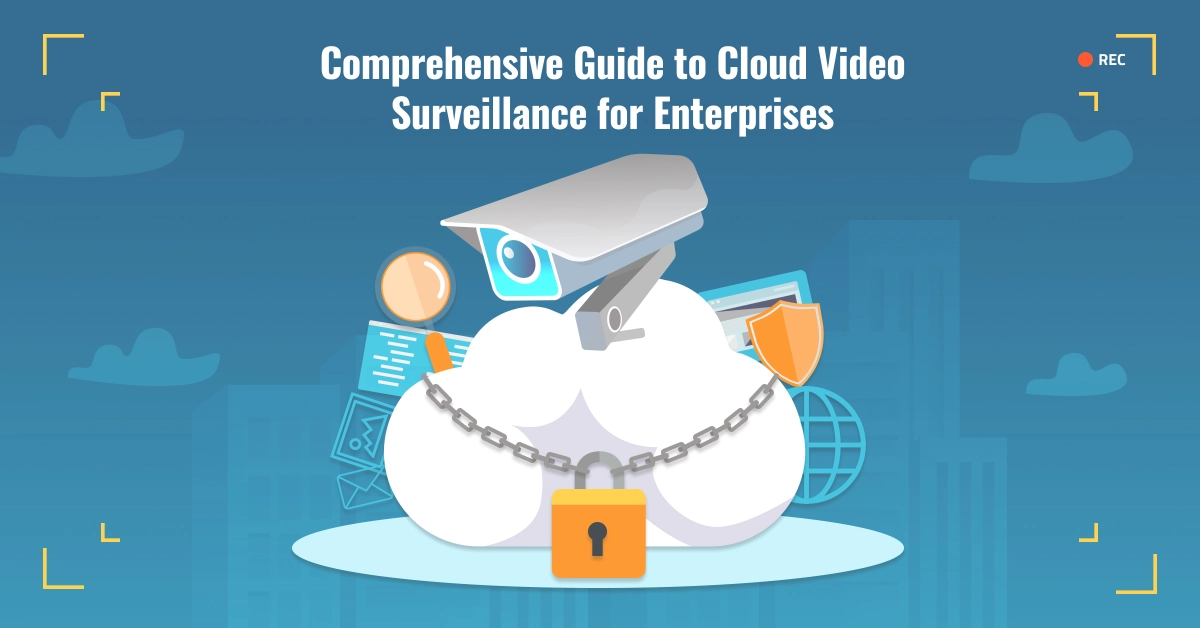
Table of Contents
It has been about a decade since the breakthrough of the cloud disrupted the entire technological landscape, propelling industries worldwide to transition from hardware storage.
Fast-forward to today, when the cloud has become fundamental. It serves as a modern launchpad for innovations. One such significant innovation thriving in the cloud is cloud video surveillance. With its potential to transform traditional security perceptions, the concept garners substantial traction from diverse industries, gradually heading toward mass-scale adoption similar to the cloud.
While the video surveillance market (VSaaS) saw a market capitalisation of USD 53.74 billion by the end of 2023, projections indicate it may reach USD 97.63 billion at a CAGR of 12.98% by 2033. The steady growth can be attributed to the convergence of technological advancements, including Cloud Computing, Artificial Intelligence, Machine Learning, the Internet of Things, and Edge Computing. Besides driving market expansion, these technologies also align with Industry 4.0 objectives, further enriching this narrative of progress.
As we explore the impact and benefits of this innovation, it is essential to understand the evolution, core principles and functionalities that define cloud-based video surveillance.
What is Cloud Video Surveillance?
Cloud video surveillance systems embody a modern surveillance approach in which security cameras transmit footage over the network to the cloud, bypassing traditional storage methods like flash drives. This means that recordings from multiple locations—say, 100 branches across the country—are fetched by the router or processed within the cloud IP camera and transmitted to a centralised cloud, ensuring 24/7 accessibility.
Thanks to features like redundancy, these cloud-based video surveillance systems effectively overcome the limitations of traditional surveillance, including the risk of footage loss. Their commitment to achieving ~100% compliance with strict regulatory mandates regarding video storage, coupled with a strong emphasis on security, further positions them as a fundamental surveillance strategy. User access control and two-factor authentication protect the footage data from potential intrusion.
With increasing regulatory scrutiny and the ever-present threat of breaches, a robust surveillance solution was essential. Given that over 50% of organisations worldwide already employ cloud services, shifting to cloud-based video surveillance was ideal. The potential benefits are compelling, often prompting industries towards adoption.
However, after deciding to install it, the primary concern is understanding its operational mechanics. Fortunately, grasping how it works is easier than it may initially seem.
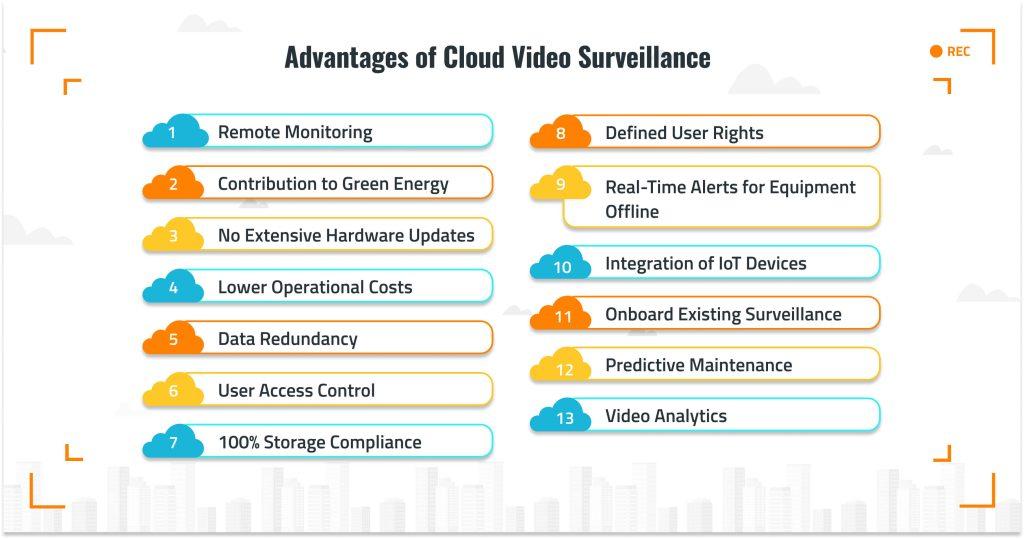
How does Cloud Video Surveillance Work?
Cloud-based video surveillance involves IP cameras connected to the router, which can transmit data to a remote cloud server for storage and processing. Here is a step-by-step breakdown of the process:
Step 1: Surveillance Camera Connection
The surveillance camera is connected to a Power over Ethernet (PoE) switch via a Local Area Network (LAN) cable. The PoE switch provides both power and network connectivity to the camera. Note that our cloud is compatible with leading hardware brands in the market.
Step 2: PoE Switch to Router and NVR
The PoE switch is connected to a Network Video Recorder (NVR) and router, which serves as the gateway to the Internet. While IGZY utilises TP-Link and D-Link 4 to 8 port PoE switches, the installation depends on the requirement.
Step 3: Router and NVR to Cloud
The router connects to the Internet, allowing the data from the IP camera to be transmitted over the network to an NVR and eventually to a remote cloud server. The IGZY router is specifically programmed to connect seamlessly with diverse surveillance equipment.
Step 4: Cloud Storage to IGZY Unified Platform
The footage from the IP camera is stored in the cloud. Cloud storage is customised per client requirements, and footage compression provides more space. Authorised users can access the feed from the IGZY AIoT-enabled unified platform. Our platform allows you to configure equipment settings, onboard new equipment, manage user rights, and more.
However, a key innovation in modern cloud video surveillance systems is using smart IP cameras with edge processing capabilities. These cameras handle data processing locally within the camera, including compressing video footage, performing basic analytics, and encoding data before transmission.
By processing data at the edge, these cameras reduce bandwidth usage and latency, ensuring quicker response times and more efficient data management.
But how did we get here? Technological advancements during the third and fourth industrial revolutions shaped the journey to cloud-based video surveillance. We moved from basic videotape recorders to videocassette recorders, digital video recorders (DVRs), and finally, cloud-based video storage solutions. Each stage brought improvements in recording quality and reliability, setting the foundation for the innovative surveillance capabilities we utilise today.

What are the critical developments in Video Surveillance?
- Early Beginnings: The story of video surveillance traces back to 1927 when Russian physicist Leon Theremin inadvertently developed a closed-circuit system using a camera and television. Fifteen years later, engineer Walter Bruch advanced this technology to create the world’s first CCTV system. Although these early systems laid a strong foundation, they were limited by the inability to store footage and required constant monitoring, which hindered widespread adoption. This limitation persisted after the introduction of the first publicly available CCTV camera in 1949 by Vericon, an American company.
- Videotape Recorders (VTR): Enter 1951, the inception year of the videotape recorder (VTR). Five years later, the first commercial model, the VR-1000, arrived on the market. This desk-sized equipment, which retailed for USD 50,000, allowed live images to be recorded reel-to-reel on magnetic tape but still required 24/7 monitoring.
- Videocassette Recorders (VCR): The appearance of videocassettes in 1971, however, paved the way for the mainstream adoption of surveillance cameras. They enabled recordings to be stored on more affordable and miniature videocassette recorders (VCRs). As a result, retail shops and banks extensively installed CCTV cameras with integrated VCRs from the early 1970s to the 1980s. “Who could forget those bulky shoulder-mounted camcorders?”
- Charge-Coupled Device (CCD): With the advent of charge-coupled device (CCD) technology in 1976, surveillance cameras unlocked the ability to record footage in low-light environments—a crucial leap toward the sophisticated night vision capabilities we rely on today. As camera technology progressed through the late 80s and early 90s, CCTV networks and VCRs still dominated the landscape, requiring tapes to be switched and stored—a functional system but far from ideal.
- Digital Video Recorders (DVR): The advent of the third industrial revolution propelled a shift from the traditional VTR and VCR to Digital Video Recorders (DVR). Multiple giants, including Kodak, Ampex, and Apple, debuted a range of digital products to lead the digital wave, revolutionising the storage and transmission of video data. Apple’s release of the QuickTake 100 in 1994 brought digital image capture directly to consumers, further accelerating the transition to modern, highly efficient surveillance systems.
Digital cameras began recording video footage on on-premise devices, such as hard drives and flash storage, rather than magnetic tape. Unlike video cassettes, this footage was of higher resolution and did not decay over time. The development of digital multiplexers in the mid-90s allowed a single DVR to capture and save footage from multiple cameras, forming the basis of the multi-camera security systems used today.

- Network Video Recorders (NVR): NVRs emerged as a natural evolution from DVRs, inheriting the benefits of digital recording, such as higher resolution and extended storage life, but with a significant enhancement: network connectivity. NVRs utilise a network of IP cameras that encode video data (often using codecs like H.264 or H.265) and transmit it over the network to the NVR for centralised management.
- Cloud IP Cameras: This digital migration saw innovation take hold, and in 1996, the first IP (internet protocol) camera—the Axis NetEye 200—was introduced. Note that Cloud IP cameras are network-connected surveillance cameras that transmit video footage to the cloud, allowing remote access, monitoring, and seamless management over the Internet.
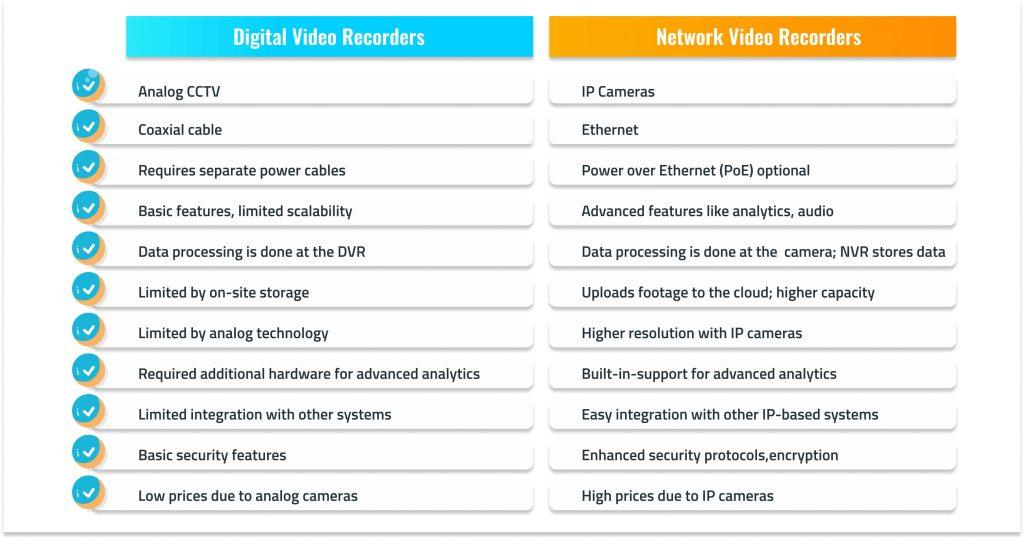
Leveraging The AI Edge to Amplify Cloud Video Surveillance Benefits
The International Association of Chiefs of Police (IACP) reported that human operators can effectively monitor surveillance footage for about 20 minutes before fatigue sets in. However, AI-powered video analytics platforms can analyse video feeds continuously, detecting and alerting operators to suspicious activities without human intervention. Not just this, Artificial Intelligence boast multiple different benefits:
- Redundant Footage and Data Management: A study by IHS Markit found that in 2020, surveillance cameras worldwide generated over 566 petabytes of video data daily. Storing such vast amounts of footage, much of which is redundant or irrelevant, results in excessive storage costs and complex management challenges. AI-based video analytics can reduce storage requirements by filtering out redundant footage and saving relevant events. Techniques like Convolutional Neural Networks (CNNs) and Temporal Convolutional Networks (TCNs) excel at detecting and categorising important objects and activities within video streams, ensuring that only critical data is stored.
- Compression and Quality Loss: Traditional video compression techniques can degrade the quality of footage, making it challenging to identify details. AI-enhanced video compression algorithms, such as Google’s AI-based codec, use neural networks to predict and reconstruct video frames, achieving higher quality at lower bit rates. Additionally, Super-Resolution Algorithms like Generative Adversarial Networks (GANs) further enhance the resolution and quality of compressed video frames by filling in lost details and improving visual clarity.
- Bandwidth Constraints: High-resolution video streaming consumes significant bandwidth. For instance, a single 1080p camera streaming at 5 Mbps can use over 2 TB of data per month. AI-driven solutions like edge processing can optimise bandwidth usage by processing video locally and transmitting compressed video to the cloud. Additionally, adaptive streaming monitors real-time network conditions, dynamically adjusting video resolution and bitrate to optimise bandwidth usage while maintaining acceptable video quality.
- Scalability: The number of connected surveillance cameras is increasing, spurring the volume of data exponentially. While in 2020, there were over 770 million surveillance cameras globally, this number is only to rise. AI systems like those developed by Hikvision can simultaneously manage and analyse data from thousands of cameras, providing scalable surveillance solutions.
IoT Integration in Cloud-based Video Surveillance
The rapid advancement of technology has transformed the landscape of video surveillance, with the integration of the Internet of Things (IoT) at the forefront of this evolution. IoT-enabled cloud video surveillance systems are revolutionising how organisations monitor premises. By leveraging:
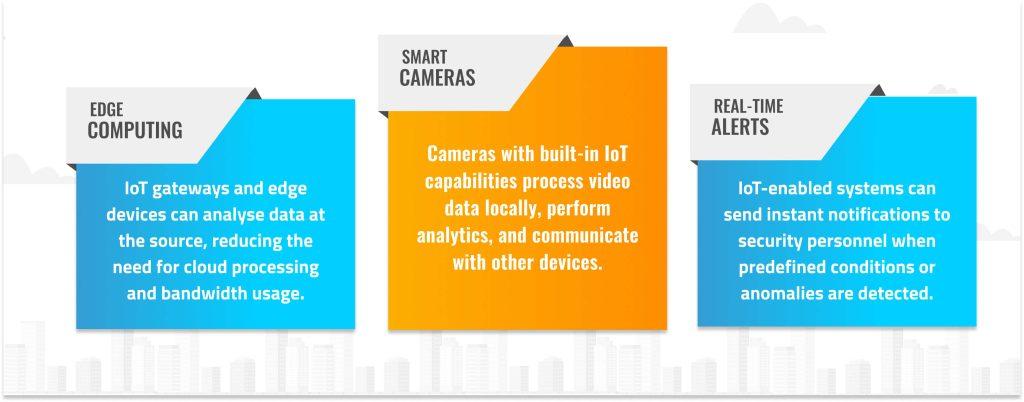
Overcoming challenges with IoT
- Interoperability and Integration: Integrating surveillance cameras and equipment from various manufacturers can be challenging. However, IoT standards and protocols promote interoperability, enabling seamless integration and ensuring all devices work together in a unified surveillance system.
- Real-Time Monitoring and Alerts: Traditional surveillance systems lack real-time monitoring capabilities, delaying incident response times. IoT-enabled surveillance systems address this issue by providing real-time monitoring and alerting via smart cameras and IoT sensors. Upon detecting unusual activity, an alert is sent to the command centre for verification. Security personnel are promptly informed for immediate action if the alert is confirmed.
- Maintenance and Reliability: Regular maintenance can be challenging across large surveillance networks when knowing if a camera is offline. However, the IGZY IoT dashboard addresses this by immediately sending notifications if equipment goes offline. It allows for continuous performance monitoring. Device health checks through an annual maintenance contract (AMC) further improve the reliability and uptime of surveillance systems.
- Bandwidth and Latency Issues: High-resolution video streams require significant bandwidth, leading to network congestion and latency issues. IoT-enabled edge devices process and analyse video data locally, reducing the amount of data transmitted to the cloud and minimising latency. For example, smart cameras can perform real-time analytics at the edge, only sending relevant data or alerts to the cloud.
Use of Cloud Video Surveillance across Industries
1. ~100% Regulatory Compliance for Banks
Banks have prioritised meeting stringent regulatory compliance standards to avoid hefty penalties. With the cloud video surveillance edge, Indian banks can install security cameras at entry, exit, and vault rooms while ensuring compliance with the Reserve Bank of India’s mandate for 180-day footage retention. Despite a significant decline in security breaches last year, incidents still occur, potentially damaging the bank’s reputation. Implementing cloud video surveillance in Banks with IGZY includes a unified AIoT dashboard for centralised visibility of all equipment, real-time camera feeds from multiple locations, and much more, ensuring comprehensive security coverage without gaps.
IGZY Cloud-based Video Surveillance and unified platform has significantly fortified India’s foremost non-banking financial company (NBFC) security posture. This partnership has proven resilient over the past five years, with no severe breaches reported post-installation.
2. Delivering Customer Experience in Retail
The concept remains the same whether you call it cloud video surveillance or a retail customer experience strategy. Retailers worldwide now employ cloud-based video surveillance combined with AI-powered analytics and IoT-edge to enhance customer experience and in-store security.
By utilising IP cameras and sensors for monitoring, they receive real-time alerts and prevent theft. Note that the chances of internal theft in retail loom large to date. AI-driven analytics empower retailers to gain profound insights into customer behaviour, preferences, and shopping patterns, leading to personalised marketing strategies and optimised store layouts.
Customisable cloud storage ensures strict compliance with video storage regulations, while the remote management of multiple sites through IGZY’s unified dashboard provides retail managers with enhanced flexibility and control.
A few years back, IGZY partnered with a leading Indian clothing and apparel giant. With over 200 exclusive outlets and more than 1300 multi-brand outlets, the retail chain saw significant challenges, including ineffective bill validation by security guards, the absence of monitoring systems for store opening and closing times, inadequate mechanisms to track customer experience, compliance issues related to store hygiene, and difficulties with managing inward stock movement and sorting processes.
However, significant improvements were observed after implementing cloud video surveillance solutions. Compliance rates surged to 90% within six months, and inward stock movement has maintained a perfect record of 100% for the past three months. Post-customer visit, stock sorting now achieves a flawless 100%.
3. Operational Excellence for Warehouses
Warehouses have become the cornerstone of modern commerce, driven by the exponential growth of e-commerce and the rising demand for efficient, intelligent storage solutions. This growth is propelling the evolution of warehouses from simple storage facilities into “centres of innovation” that harness cutting-edge technologies to ensure seamless operations and excel in this competitive landscape.
This rapid growth presents several challenges for traditional warehouses that rely on manual processes and need more automation, including damage, spoilage, inaccurate demand forecasting, stockouts, overstock, and labour inefficiency.
Nevertheless, integrating cloud video surveillance and IoT in warehouse management with the convergence of automation, robotics, data analytics, and other innovative technologies has provided a potent toolkit to streamline processes, optimise resource allocation, and meet the ever-changing demands of the modern supply chain.
IGZY AIoT Dashboard for Cloud-based Video Surveillance
As mentioned above, cloud-based video surveillance is sparking a revolution driven by the convergence of cutting-edge technologies. It may soon reach mass-scale adoption, replacing traditional surveillance systems and becoming fundamental at the grassroots. IGZY’s AIoT-enabled dashboard further complements cloud-based surveillance with a centralised view of live camera feed from multiple locations, user access control and defined rights.
“Leading Innovation in Surveillance: Sense, Analyse, Act”
With over a decade of expertise, IGZY operates on the mantra “Sense, Analyse, Act” in surveillance solutions. Our advanced equipment, including security cameras and sensors, detect any suspicious activity as the initial step. These alerts are promptly relayed to our platform, where they undergo rigorous verification (within 5 minutes) at our backend command centre—a crucial second step. Subsequently, decisive actions are taken based on meticulous analysis, ensuring rapid response measures.


